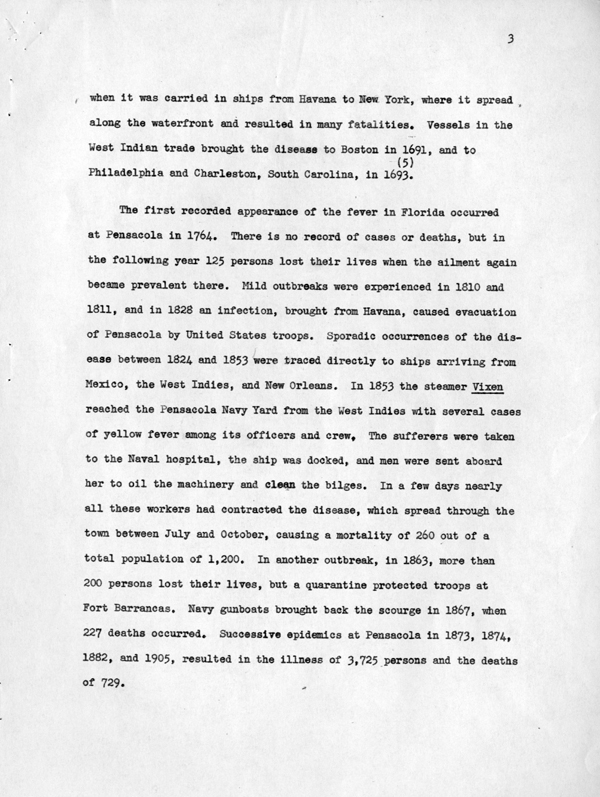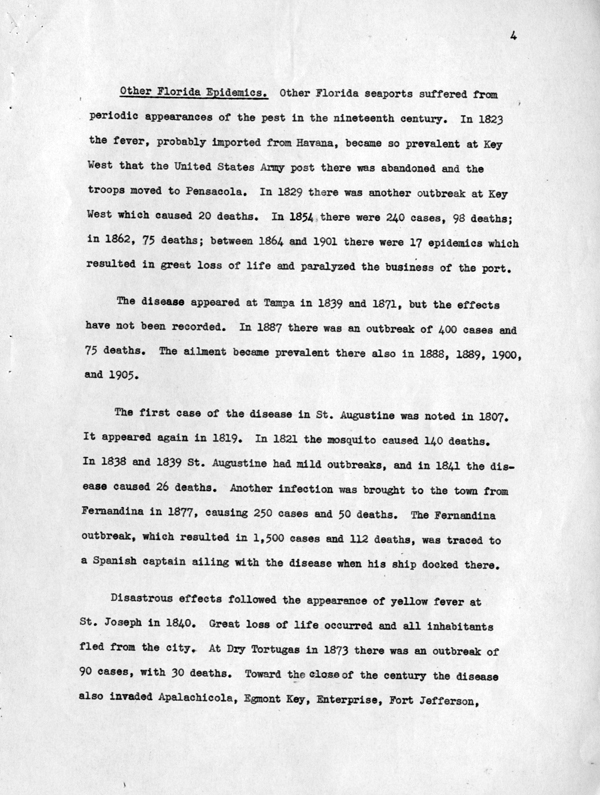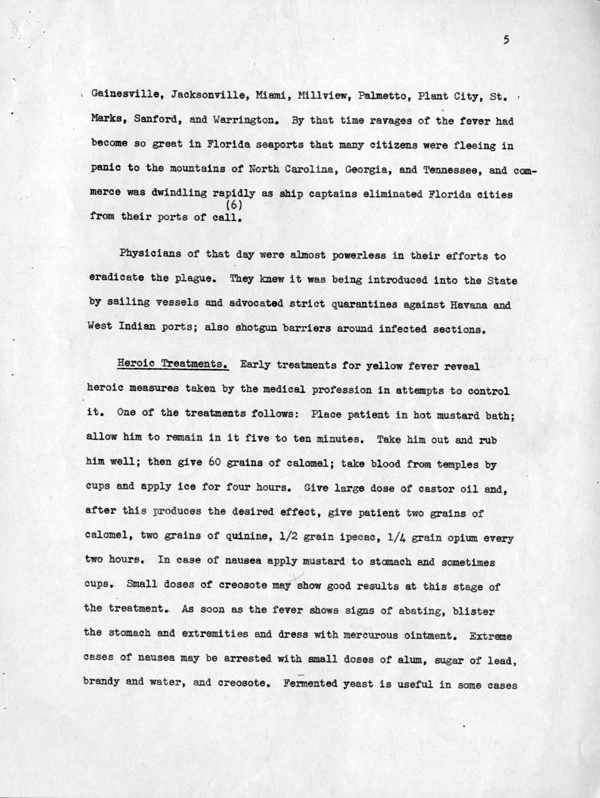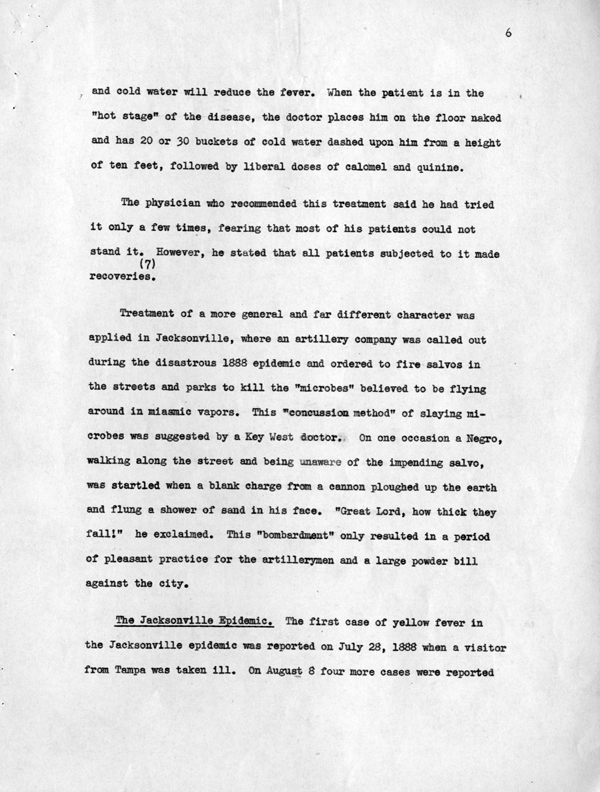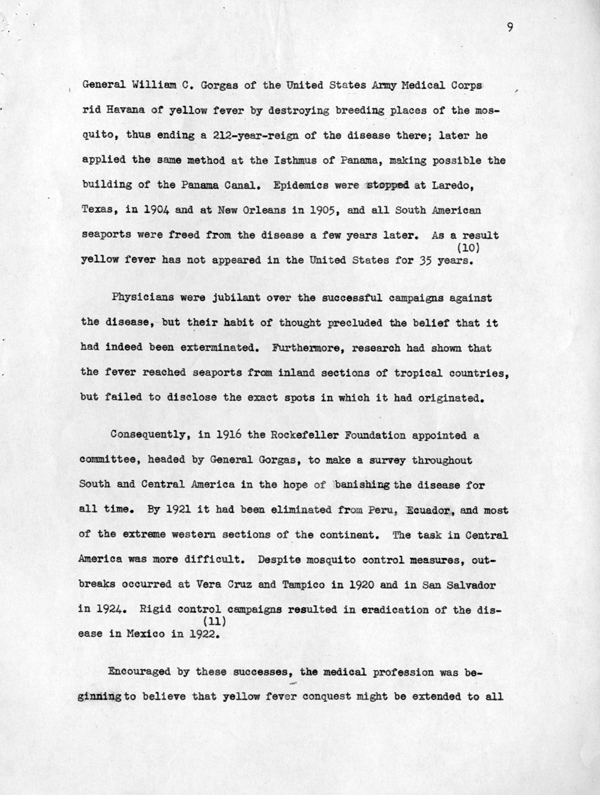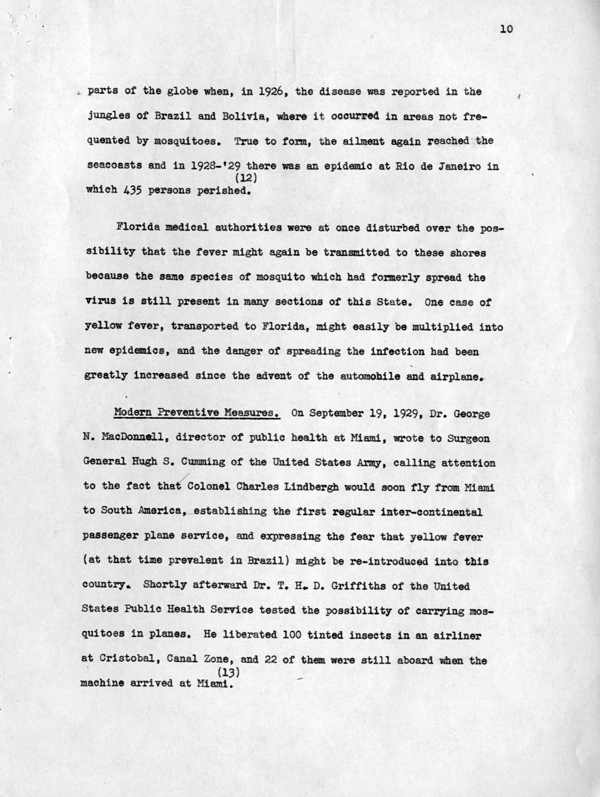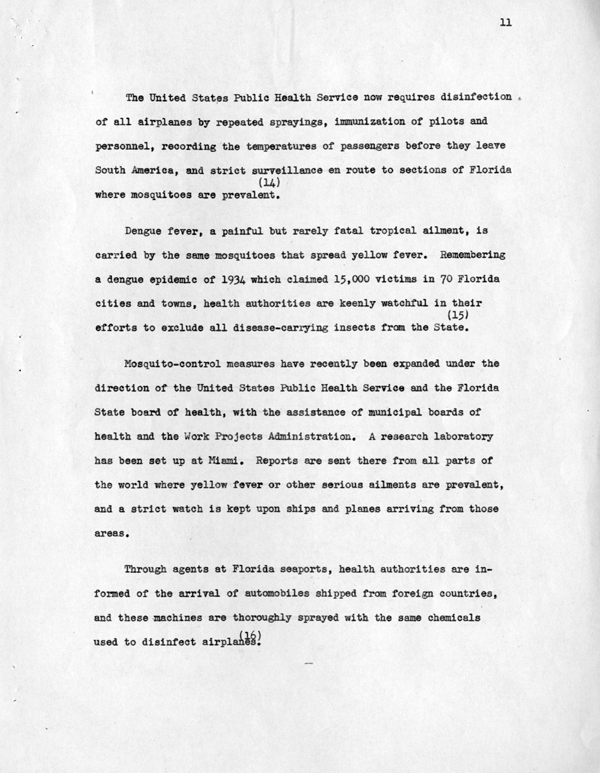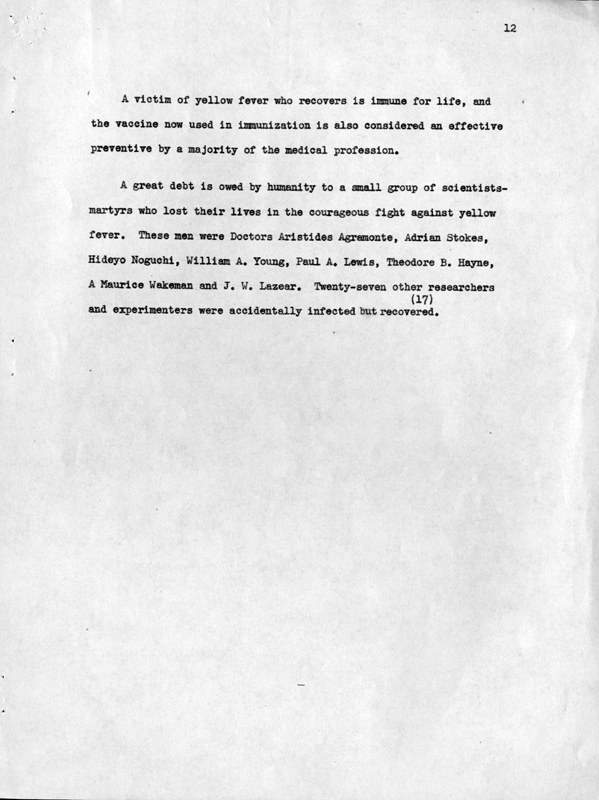Florida Memory is administered by the Florida Department of State, Division of Library and Information Services, Bureau of Archives and Records Management. The digitized records on Florida Memory come from the collections of the State Archives of Florida and the special collections of the State Library of Florida.

State Archives of Florida
- ArchivesFlorida.com
- State Archives Online Catalog
- ArchivesFlorida.com
- ArchivesFlorida.com
State Library of Florida
Related Sites
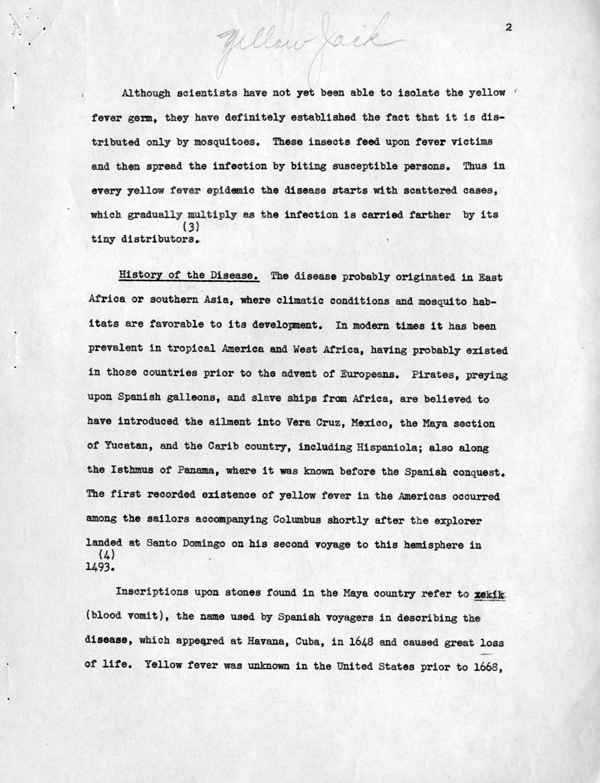
Description of previous item
Description of next item

Title
Published Date
[page 2]
Although scientists have not yet been able to isolate the yellow
fever germ, they have definitely established the fact that it is distributed
only by mosquitoes. These insects feed upon fever victims and then
spread the infection by biting susceptible persons. Thus in every yellow
fever epidemic the disease starts with scattered cases, which gradually
multiply as the infection is carried farther by its tiny distributors. (3)
History of the Disease. The disease probably originated in East
Africa or southern Asia, where climatic conditions and mosquito habitats
are favorable to its development. In modern times it has been prevalent
in tropical America and West Africa, having probably existed in those
countries prior to the advent of Europeans. Pirates, preying upon
Spanish galleons, and slave ships from Africa, are believed to have
introduced the ailment into Vera Cruz, Mexico, the Maya section of
Yucatan, and the Carib country, including Hispaniola; also along the
Isthmus of Panama, where it was known before the Spanish conquest.
The first recorded existence of yellow fever in the Americas occurred
among the sailors accompanying Columbus shortly after the explorer
landed at Santo Domingo on his second voyage to this hemisphere in
1493. (4)
Inscriptions upon stones found in the Maya country refer to xekik
(blood vomit), the name used by Spanish voyagers in describing the
disease, which appeared at Havana, Cuba, in 1648 and caused great loss
of life. Yellow fever was unknown in the United States prior to 1668,
[page 3]
when it was carried in ships from Havana to New York, where it spread
along the waterfront and resulted in many fatalities. Vessels in the West
Indian trade brought the disease to Boston in 1691, and to Philadelphia
and Charleston, South Carolina, in 1693. (5)
The first recorded appearance of the fever in Florida occurred at
Pensacola in 1764. There is no record of cases or deaths, but in the
following year 125 persons lost their lives when the ailment again became
prevalent there. Mild outbreaks were experienced in 1810 and 1811, and
in 1828 an infection, brought from Havana, caused evacuation of
Pensacola by United States troops. Sporadic occurrences of the disease
between 1824 and 1853 were traced directly to ships arriving from
Mexico, the West Indies, and New Orleans. In 1853 the steamer Vixen
reached the Pensacola Navy Yard from the West Indies with several
cases of yellow fever among its officers and crew. The sufferers were
taken to the Naval hospital, the ship was docked, and men were sent
aboard her to oil the machinery and clean the bilges. In a few days
nearly all these works had contracted the disease, which spread through
the town between July and October, causing a mortality of 260 out of a
total population of 1,200. In another outbreak, in 1863, more than 200
persons lost their lives, but a quarantine protected troops at Fort
Barrancas. Navy gunboats brought back the scourge in 1867, when 227
deaths occurred. Successive epidemics at Pensacola in 1873, 1874, 1882,
and 1905, resulted in the illness of 3,725 persons and the deaths of 729.
[page 4]
Other Florida Epidemics. Other Florida seaports suffered from
periodic appearances of the pest in the nineteenth century. In 1823 the
fever, probably imported from Havana, became so prevalent at Key West
that the United States Army post there was abandoned and the troops
moved to Pensacola. In 1829 there was another outbreak at Key West
which caused 20 deaths. In 1854 there were 240 cases, 98 deaths; in
1862, 75 deaths; between 1864 and 1901 there were 17 epidemics which
resulted in great loss of life and paralyzed the business of the port.
The disease appeared at Tampa in 1839 and 1871, but the effects
have not been recorded. In 1887 there was an outbreak of 400 cases and
75 deaths. The ailment became prevalent there also in 1888, 1889, 1900,
and 1905.
The first case of the disease in St. Augustine was noted in 1807.
It appeared again in 1819. In 1821 the mosquito caused 140 deaths. In
1838 and 1839 St. Augustine had mild outbreaks, and in 1841 the
disease caused 26 deaths. Another infection was brought to the town
from Fernandina in 1877, causing 250 cases and 50 deaths. The
Fernandina outbreak, which resulted in 1,500 cases and 112 deaths, was
traced to a Spanish captain ailing with the disease when his ship docked
there.
Disastrous effects followed the appearance of yellow fever at St.
Joseph in 1840. Great loss of life occurred and all inhabitants fled from
the city. At Dry Tortugas in 1874 there was an outbreak of 90 cases,
with 30 deaths. Toward the close of the century the disease also invaded
Apalachicola, Egmont Key, Enterprise, Fort Jefferson,
[page 5]
Gainesville, Jacksonville, Miami, Millview, Palmetto, Plant City, St.
Marks, Sanford, and Warrington. By that time ravages of the fever had
become so great in Florida seaports that many citizens were fleeing in
panic to the mountains of North Carolina, Georgia, and Tennessee, and
commerce was dwindling rapidly as ship captains eliminated Florida
cities from their ports of call. (6)
Physicians of that day were almost powerless in their efforts to
eradicate the plague. They knew it was being introduced into the State
by sailing vessels and advocated strict quarantines against Havana and
West Indian ports; also shotgun barriers around infected sections.
Heroic Treatments. Early treatments for yellow fever reveal
heroic measures taken by the medical profession in attempts to control it.
One of the treatments follows: Place patient in hot mustard bath; allow
him to remain in it five to ten minutes. Take him out and rub him well;
then give 60 grains of calomel; take blood from temples by cups and
apply ice for four hours. Give large dose of castor oil and, after this
produces the desired effect, give patient two grains of calomel, two
grains of quinine, 1/2 grain ipecac, 1/4 grain opium every two hours. In
case of nausea apply mustard to stomach and sometimes cups. Small
doses of creosote may show good results at this stage of the treatment.
As soon as the fever shows signs of abating, blister the stomach and
extremities and dress with mercurous ointment. Extreme cases of nausea
may be arrested with small doses of alum, sugar of lead, brandy and
water, and creosote. Fermented yeast is useful in some cases
[page 6]
and cold water will reduce the fever. When the patient is in the "hot
stage" of the disease, the doctor places him on the floor naked and has
20 or 30 buckets of cold water dashed upon him from a height of ten
feet, followed by liberal doses of calomel and quinine.
The physician who recommended this treatment said he had tried
it only a few times, fearing that most of his patients could not stand it.
However, he stated that all patients subjected to it made recoveries. (7)
Treatment of a more general and far different character was
applied in Jacksonville, where an artillery company was called out during
the disastrous 1888 epidemic and ordered to fire salvos in the streets and
parks to kill the "microbes" believed to be flying around in miasmic
vapors. The "concussion method" of slaying microbes was suggested by
a Key West doctor. On one occasion a Negro, walking along the street
and being unaware of the impending salvo, was startled when a blank
charge from a cannon ploughed up the earth and flung a shower of sand
in his face. "Great Lord, how thick they fall!" he exclaimed. This
"bombardment" only resulted in a period of pleasant practice for the
artillerymen and a large powder bill against the city.
The Jacksonville Epidemic. The first case of yellow fever in the
Jacksonville epidemic was reported on July 28, 1888 when a visitor from
Tampa was taken ill. On August 8 four more cases were reported
[page 7]
and several hundred alarmed citizens fled from the city. Five more cases
developed the next day and the board of health issued a proclamation stating
that the fever was prevalent and might assume the proportions of an epidemic.
Panic followed this pronouncement. Outgoing trains and boats
were crowded, places of business were closed and frightened citizens
besieged doctors' offices with frantic appeals for protection against the
plague. The board of health prohibited public assemblages and put large
groups of men to work scattering lime through streets, yards, and parks.
Restaurants were padlocked and many citizens, unable to obtain cooked
food, hired amateur chefs and set up their own eating places. Finally
railroad and steamship companies discontinued their services to the
stricken city, causing a shortage of provisions and the threat of famine.
Farmers living nearby were afraid to bring in eggs and produce.
Reports reached Jacksonville that the Federal Government had
appropriated $200,000 for victims of the epidemic and a flood of
requests for money and rations descended upon the city's relief
committee. The committee declared the reports were untrue, but the
public doubted the statement and retorted with a storm of abuse freely
mixed with threats of bodily harm. Finally, in desperation, the
committee suggested that the city be depopulated, but only 4,000 out of
14,000 residents agreed to depart, and a majority of these took refuge at
the nearby settlements of Camp Perry, Macclenny, and Sanderson.
[page 8]
Throughout the epidemic the board of health tried to confine the
plague to certain sections of the city and give 24-hour-a-day attention to
the increasing number of victims. Half a dozen prominent local
physicians, with others who had offered their assistance, lost their lives
before it was reported, on November 26, that no new cases had
developed. Three days later, Thanksgiving services were held in all the
churches, and citizens who had fled during the scourge began to return
to their homes. (8)
An Epochal Discovery
Statistics of the Jacksonville epidemic and others throughout the
State showed that the fever always appeared in hot weather and
subsided after the first frost in the fall. On some occasions it persisted
during cool weather, but almost invariably vanished when temperatures
fell below the 50-degree mark. Physicians concluded, therefore, that the
frost killed the microbes, and were experimenting with carbolic acid, lime
and other chemicals to find a "hot-weather" germ killer when Dr. Carlos
Finley of Havana suggested that a species of mosquito was spreading the
disease. His theory was proven correct by Doctor Walter Reed and a
group of other United States Army doctors, surgeons and enlisted men,
who conducted a series of experiments at Camp Columbia, Cuba, in
1900 after the fever had broken out among soldiers there. (9)
This epochal discovery was followed quickly by mosquito-control
measures at Havana, Panama, and South American seaports. In 15 months
[page 9]
General William C. Gorgas of the United States Army Medical Corps rid
Havana of yellow fever by destroying breeding places of the mosquito,
thus ending a 212-year-reign of the disease there; later he applied the
same method at the Isthmus of Panama, making possible the building of
the Panama Canal. Epidemics were stopped at Laredo, Texas, in 1904
and at New Orleans in 1905, and all South American seaports were freed
from the disease a few years later. As a result yellow fever has not
appeared in the United States for 35 years. (10)
Physicians were jubilant over the successful campaigns against
the disease, but their habit of thought precluded the belief that it had
indeed been exterminated. Furthermore, research had shown that the
fever reached seaports from inland sections of tropical countries, but
failed to disclose the exact spots in which it had originated.
Consequently, in 1916 the Rockefeller Foundation appointed a
committee, headed by General Gorgas, to make a survey throughout South
and Central America in the hope of banishing the disease for all time. By
1921 it had been eliminated from Peru, Ecuador, and most of the extreme
western sections of the continent. The task in Central America was more
difficult. Despite mosquito control measures, out-breaks occurred at Vera
Cruz and Tampico in 1920 and in San Salvador in 1924. Rigid control
campaigns resulted in eradication of the disease in Mexico in 1922. (11)
Encouraged by these successes, the medical profession was
beginning to believe that yellow fever conquest might be extended to all
[Page 10]
parts of the globe when, in 1926, the disease was reported in the jungles of
Brazil and Bolivia, where it occurred in areas not frequented by
mosquitoes. True to form, the ailment again reached the seacoasts and in
1928-'29 there was an epidemic at Rio de Janeiro in which 435 persons
perished. (12)
Florida medical authorities were at once disturbed over the
possibility that the fever might again be transmitted to these shores
because the same species of mosquito which had formerly spread the
virus is still present in many sections of this State. One case of yellow
fever, transported to Florida, might easily be multiplied into new
epidemics, and the danger of spreading the infection had been greatly
increased since the advent of the automobile and airplane.
Modern Preventive Measures. On September 19, 1929, Dr.
George N. MacDonnell, director of public health at Miami, wrote to
Surgeon General Hugh S. Cumming of the United States Army, calling
attention to the fact that Colonel Charles Lindberg would soon fly from
Miami to South America, establishing the first regular inter-continental
passenger plane service, and expressing the fear that yellow fever (at that
time prevalent in Brazil) might be re-introduced into this country. Shortly
afterward Dr. T. H. D. Griffiths of the United States Public Health
Service tested the possibility of carrying mosquitoes in planes. He
liberated 100 tinted insects in an airliner at Cristobal, Canal Zone, and 22
of them were still aboard when the machine arrived at Miami. (13)
[page 11]
The United States Public Health Service now requires
disinfection of all airplanes by repeated sprayings, immunization of pilots
and personnel, recording the temperatures of passengers before they
leave South America, and strict surveillance en route to sections of
Florida where mosquitoes are prevalent. (14)
Dengue fever, a painful but rarely fatal tropical ailment, is carried
by the same mosquitoes that spread yellow fever. Remembering a
dengue epidemic of 1934 which claimed 15,000 victims in 70 Florida
cities and towns, health authorities are keenly watchful in their efforts to
exclude all disease-carrying insects from the State.(15)
Mosquito-control measures have recently been expanded under
the direction of the United States Public Health Services and the Florida
State board of health, with the assistance of municipal boards of health
and the Work Projects Administration. A research laboratory has been
set up at Miami. Reports are sent there from all parts of the world where
yellow fever or other serious ailments are prevalent, and a strict watch is
kept upon ships and planes arriving from those areas.
Through agents at Florida seaports, health authorities are
informed of the arrival of automobiles shipped from foreign countries,
and these machines are thoroughly sprayed with the same chemicals used
to disinfect airplanes. (16)
[page 12]
A victim of yellow fever who recovers is immune for life, and the
vaccine now used in immunization is also considered an effective
preventive by a majority of the medical profession.
A great debt is owned by humanity to a small group of scientists-
martyrs who lost their lives in the courageous fight against yellow fever.
These men were Doctors Aristides Agramonte, Adrian Stokes, Hideyo
Noguchi, William A. Young, Paul A. Lewis, Theodore B. Hayne, A
Maurice Wakeman and J. W. Lazear. Twenty-seven other researchers
and experimenters were accidentally infected but recovered. (17)
[page 13]
CITATIONS
1. Report of the Jacksonville Auxiliary Santiary Association on the
Epidemic of 1888 (Appendix).
2. Parasitism and Disease; Smith, Theobald; Rockefeller Institute for
Medical Research, 1934; pp. 155-156.
3. Smith, p. 157.
Report on the Etiology and Prevention of Yellow Fever; Sternberg,
George M., Surgeon U. S. Army, 1890; pp. 11-35.
4. Yellow Fever; Carter, Henry Rose; 1931; pp. 145, 152, 153, 154.
5. History of Yellow Fever; Augustin, George; 1909, pp. 639, 767.
Carter, pp. 265-271.
6. Ibid. pp. 810-813, 814, 806, 805, 815.
7. Letter from Dr. William J. L'Engle, Key West, to his cousin, Col.
Miller Hallowes, St. Marys, Ga., Nov. 10, 1854. (In Library
Florida State Board of Health).
8. Report of Sanitary Association (see Citation 1); pp. 11-75; 116-
117.
9. Walter Reed and Yellow Fever; Kelly, Dr. Howard A.; 1906; pp. 122-
149.
10. Paper on "Yellow Jack"; MacDonnell, Dr. George N.: Director of
Public Health, Miami, Fla.; 1938 (in library at Florida State Board of
Health).
11. History of Yellow River Since the New Orleans Epidemic of 1905;
Sawyer, Dr. W. A. (Reprint from Southern Medical Journal,
March 1932; pp. 291-296 (In library Florida State Board of
Health).
12. Paper on "Yellow Jack"; MacDonnell, Dr. George N.; Director of
Public Health, Miami, Fla.; 1938 (in library at Florida State
Board of Health).
13. History of Yellow Fever Since the New Orleans Epidemic of 1905;
Sawyer, Dr. W. A. (Reprint from Southern Medical Journal,
March 1932; pp. 291-296 (In library Florida State Board of
Health).
[page 14]
14. Ibid.
15-16. Catlett, George F.; Director Bureau of Engineering, Florida
State Board of Health
17. History of Yellow Fever Since the New Orleans Epidemic of 1905;
Sawyer, Dr. W. A. (Reprint from Southern Medical Journal,
March 1932; pp. 291-296 (In library Florida State Board of
Health).
Title
Subject
Description
Source
Date
Contributor
Format
Language
Type
Identifier
Published Date
Image URL
Thumbnail
Transcript Path
Image Path
Image Path - Large
Chicago Manual of Style
Yellow Jack. 1941. State Archives of Florida, Florida Memory. <https://www.floridamemory.com/items/show/181551>, accessed 16 December 2025.
MLA
Yellow Jack. 1941. State Archives of Florida, Florida Memory. Accessed 16 Dec. 2025.<https://www.floridamemory.com/items/show/181551>
AP Style Photo Citation

 Listen: The Blues Program
Listen: The Blues Program

